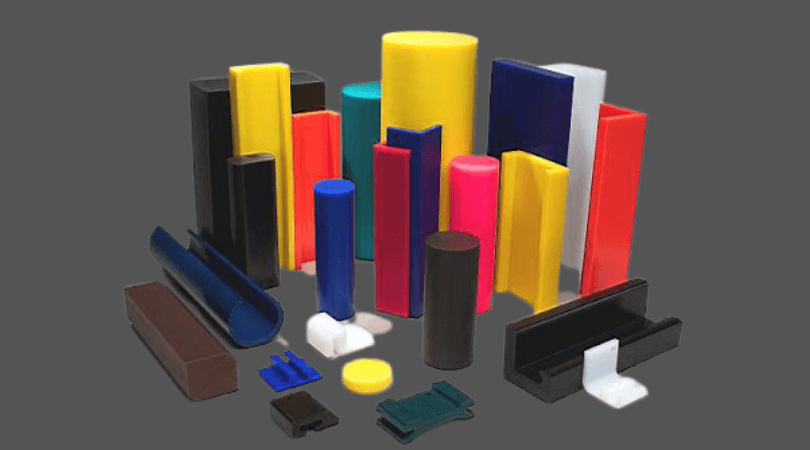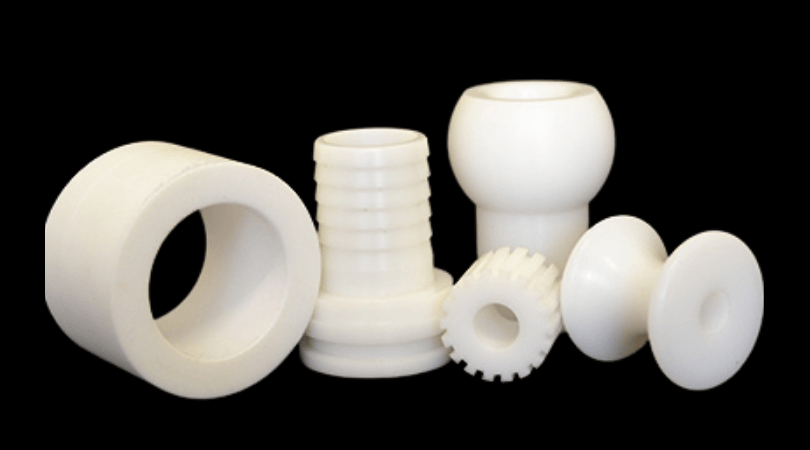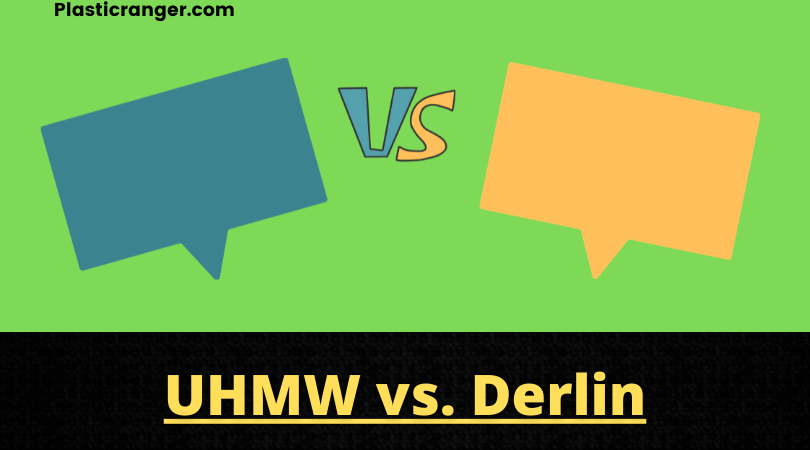Hello people; the plastic community is full of jargon, which sometimes makes things confusing to understand.
Thus, I have researched extensively to make a detailed guide on the difference between UHMW and Delrin. So let’s get started.
UHMW VS Delrin
UHMW vs. Delrin is a significant question for many plastic manufacturers. Both are high-performance plastic materials with various applications, but how do you choose between them?
UHMW and Delrin are thermoplastic materials with high strength and low friction properties. UHMW is known for its excellent impact and chemical resistance, while Delrin is known for its high stiffness and dimensional stability. Both materials are commonly used in industrial applications such as gears, bearings, and wear strips.
Let’s see a detailed differentiation between both plastics.
Ultra-High Molecular Weight Polyethylene (UHMW)

UHMW is a tough, rigid plastic material with excellent abrasion and wear resistance. It is a subgroup of polyethylene with a more extended structure of chains, helping it transfer the polymer backbone’s load and weight more efficiently by toughening intermolecular linkages.
It is compatible with high-end industrial applications thanks to its durability, lightweight, chemical resistance, low friction, and one of the highest recorded impact strengths in any thermoplastic material.
UHMW is resistant to most chemicals, microorganisms, and UV radiation but doesn’t have the same creep resistance as Delrin
Typical applications of UHMW plastic include:
Industrial Applications: Climbing equipment, automotive winching, bowstrings, personal protection armors, high-performance sails, cut-resistant gloves, spearguns, and suspension lines in parachutes.
Wires & Cables: Cable insulation and Cable jacketing.
Medical: Biomaterial for hips, knee, and spine replacement implants, clinical hip replacements,
Marine Infrastructure: Mooring of ships and floating structures.
Below is a table with typical properties of Ultra-high Molecular Weight Polyethylene:
| Property | Unit |
| Tensile Strength | 3100 psi |
| Specific Gravity | 1.45 g/cc |
| Hardness, Shore D | 64 |
| Flexural Modulus | 61-110 ksi |
| Compressive Strength | 3600 psi |
| Water Absorption @ 24H/Saturation | 0.01% |
| Izod Impact, Notched | 18 ft-lbs/in. |
| Compressive Modulus | 84 ksi |
| Coefficient of Friction | 0.14 |
| Melting Point | 155°C |
| Maximum Service Temperature | 82-85°C |
| Elongation at Break | 125% |
Delrin

There is a lot of confusion between Derlin and acetal. While all Delrin is acetal, not all Acetal is Delrin. Acetal is a more commonly known name for the PolyOxyMethylene (POM) family of thermoplastics.
Acetal is available in two forms – homopolymer and copolymer. Delrin is a popular name for acetal homopolymer.
Delrin is a little better in terms of mechanical properties than copolymer acetal because of greater regularity in its structure.
Still, it often contains a low-density center, commonly seen in large cross-sections.
Its chemical resistance is slightly lower than copolymer but is perfect for applications with small diameters and thin-walled bushings.
Delrin is stiffer and stronger in unfilled form, has shorter molding cycles, is easy to machine, has low moisture absorption, and has a better surface finish.
The limitation of using Delrin is porosity. A noticeable centerline is made by gassing during manufacturing and can cause machining and moisture permeation through the material.
That’s why Derlin is not used in food and medical applications due to the possible chances of bacteria growth.
Below is a table with specific properties of Derlin:
| Property | Unit | Range |
| Molar Volume Vm | mL mol-1 | 22.0 – 26.4 |
| Density ρ | g mL-1 | 1.14 – 1.36 |
| Molecular Weight of Repeat unit | g mol-1 | 30.03 |
| Van-der-Waals Volume VvW | mL mol-1 | 12.25 |
| Solubility Parameter δ | MPa1/2 | 19.9 – 22.9 |
| Molar Heat Capacity Cp | J (mol K)-1 | 62 – 66 |
| Entanglement Molecular Weight Me | g mol-1 | 2000 – 3700 |
| Index of Refraction n | – | 1.44 – 1.48 |
| Molar Cohesive Energy | J mol-1 | 10100 – 11500 |
| Glass Transition Temperature Tg | K | 207 – 226 |
Applications
- Safety restraint components
- Door system components
- Zip fasteners
- Ski building
- Medical delivery devices
- Conveyer system components
- Gears
Engaging Read – PTFE Vs. Teflon: A Comprehensive Comparision
The Major Differences Between Delrin VS UHMW
| Property | UHMW | Derlin |
| Tensile Strength | 3100 | 10,000 |
| Water Absorbtion Rating | Slight | 0.25 |
| Flexural Modulus | 110,000 | 420 |
| Coefficient of Linear Thermal Expansion | 11.1 | 6.8 |
| Applications | Starwheels, bushings, bumpers, chain guides, wear stripes, plates, Sprockets, and guide rails. |
Bushings, rollers, fittings, insulators, gears, bearings,
|
| Major Attributes | High abrasion resistance, zero water absorption, self-lubricating, chemical resistant, high impact strength, low coefficient of friction, machinability |
Machinability, High mechanical strength, rigidity, Low moisture absorption
|
FAQs

Below are the frequently asked questions on Delrin vs UHMW. Let’s dig deep to know more.
Is UHMW FDA approved?
Yes. It is both FDA and USDA approved for food and medical applications.
Is UHMW bulletproof?
UHMW is one of the most common plastic materials used for bulletproof applications. It is also used with other materials to produce composite armor systems.
Is Delrin stronger than nylon?
Nylon and even UHMW are nowhere near Derlin in terms of strength.
What is the world’s strongest plastic?
The world’s strongest plastic is polycarbonate. It’s 200 times stronger than glass.
Can Delrin plastic be glued?
Delrin cannot be glued to itself with a type of powerful bond. The reason is that any one-part solvent-based adhesives do not properly dissolve on the surface of Delrin material. Adhesives work by bonding two surfaces of a material.
Once the glued pieces are clamped and allowed to dry, the adhesive evaporates, becoming one bonded piece.
Suggested Read –
- Polycarbonate Vs. Acrylic | What are the Differences and Similarities?
- Plexiglass Vs. Acrylic | What are the Differences and Similarities?
- Plastics Vs. Polymers | What are the Differences?
- LDPE Vs HDPE: What are the Differences and Similarities
- Step Growth vs Chain Growth Polymerization
- CPVC VS PVC | Difference Between PVC and CPVC
- Antistatic vs. Static Dissipative Plastics | Which One to Choose?
Final Words
In conclusion, UHMW (Ultra High Molecular Weight Polyethylene) and Delrin (a brand name for POM or Polyoxymethylene) are highly regarded engineering plastics with unique strengths.
UHMW excels in wear resistance, impact strength, and low friction, making it ideal for applications requiring durability and low maintenance, such as inlining chutes and hoppers.
On the other hand, Delrin boasts superior tensile strength, rigidity, and dimensional stability, making it better suited for precision mechanical parts like gears and bearings.
The choice between UHMW and Delrin depends on the application’s specific requirements, such as the need for wear resistance or precision.
Kindly share your thoughts in the comment box.
Quick Navigation


For many years I have been using Delrin in industrial applications.
I find it very easy to work with using wood working tool, i.e. chop saws, table saws, planers etc.
I have been using it for contact blocks on a lifting tool for large block engines to prevent metal to metal contact between the engine and the picking tool.
The only issue that I have is with chipping of the Delrin during use.
Would UHMW be less susceptible to chipping while still allowing easy manufacturing?
Love sharing knowledge, even if the post is dead lol
I’d recommend UHMW for your application for sure. It’s a spongy material and very flexible and won’t chip. in fact, it’s not as easy to machine as a lot of websites claim because it’s so spongy and resists chipping. That is, the chip produced by the cut has a tendency to hang on, and get recut, and welds back on.
woodworking tools tend to have a higher rake than metal working tools, and you also tend to conventional cut with them. both of these factors make uhmw cuts better, so you shouldn’t have a problem with it as long as you’re ok with some hairs on the cut, which can be dealt with using a 120 grit sand paper and soapy water.
hope this helps
thanks for the insight
No cost comparison (Delrin appears to be about twice the price of UHMW according to McMaster)